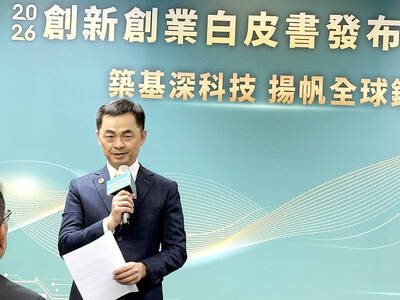US-based Intel Corp’s research arm and the Industrial Technology Research Institute (ITRI, 工研院) have created a new low-energy prototype memory array that can boost a device’s battery life.
The prototype DRAM array can achieve four times lower latency at 25 times less energy than the standard double data rate synchronous DRAM (DDR SDRAM) devices that are generally used in computers, Intel Labs said.
The improved energy efficiency can help improve the battery life of devices, integrate mobile data faster, enhance graphics with higher resolution and boost mobile user experience, it said.
Intel Labs said that technology from the prototype could be used in system-on-chip (SoC) devices for mobile devices or a memory controller for datacenter systems with large memory arrays.
The prototype is the latest in a series of continuing research efforts in advanced memory architectures by Intel Labs and ITRI since 2011. They have created experimental memory arrays and prototyping, and developed model simulation software.
“As a technology innovator for nearly half a century, Intel believes that technology can have a transformative impact on people and communities,” Intel Labs managing director Wang Wen-hann (王文漢) said on Thursday last week in Taipei.
“This belief is what drives our collaborations with governments, the research community, academia, industry and others. The goal is to enable new thinking and skills to further economic empowerment,” Wang told a news conference at the first Intel Asia Innovation Summit in Taiwan.
The Intel Asia Innovation Summit runs through today. It has brought nearly 300 attendees from China, India, South Korea, Japan, Malaysia, Singapore, the US and Vietnam to discuss key technology topics, such as the Internet of Things, wearables, interactive tech, mobility and big data.
Intel Labs also announced on Thursday last week a software prototype in cooperation with Asustek Computer Inc (華碩電腦) — the world’s fifth-largest computer maker — that can achieve 2.5 times the input and output performances of conventional storage servers.
The software prototype is being tested and validated using real-world workloads recorded from the operating systems of Asustek’s cloud unit, Asus Cloud Corp (華碩雲端), the research division said.
Intel Labs has been collaborating with the computer maker since last year to enhance the performance and cost-efficiency of cloud storage systems.

CHIP RACE: Three years of overbroad export controls drove foreign competitors to pursue their own AI chips, and ‘cost US taxpayers billions of dollars,’ Nvidia said China has figured out the US strategy for allowing it to buy Nvidia Corp’s H200s and is rejecting the artificial intelligence (AI) chip in favor of domestically developed semiconductors, White House AI adviser David Sacks said, citing news reports. US President Donald Trump on Monday said that he would allow shipments of Nvidia’s H200 chips to China, part of an administration effort backed by Sacks to challenge Chinese tech champions such as Huawei Technologies Co (華為) by bringing US competition to their home market. On Friday, Sacks signaled that he was uncertain about whether that approach would work. “They’re rejecting our chips,” Sacks

NATIONAL SECURITY: Intel’s testing of ACM tools despite US government control ‘highlights egregious gaps in US technology protection policies,’ a former official said Chipmaker Intel Corp has tested chipmaking tools this year from a toolmaker with deep roots in China and two overseas units that were targeted by US sanctions, according to two sources with direct knowledge of the matter. Intel, which fended off calls for its CEO’s resignation from US President Donald Trump in August over his alleged ties to China, got the tools from ACM Research Inc, a Fremont, California-based producer of chipmaking equipment. Two of ACM’s units, based in Shanghai and South Korea, were among a number of firms barred last year from receiving US technology over claims they have

BARRIERS: Gudeng’s chairman said it was unlikely that the US could replicate Taiwan’s science parks in Arizona, given its strict immigration policies and cultural differences Gudeng Precision Industrial Co (家登), which supplies wafer pods to the world’s major semiconductor firms, yesterday said it is in no rush to set up production in the US due to high costs. The company supplies its customers through a warehouse in Arizona jointly operated by TSS Holdings Ltd (德鑫控股), a joint holding of Gudeng and 17 Taiwanese firms in the semiconductor supply chain, including specialty plastic compounds producer Nytex Composites Co (耐特) and automated material handling system supplier Symtek Automation Asia Co (迅得). While the company has long been exploring the feasibility of setting up production in the US to address

OPTION: Uber said it could provide higher pay for batch trips, if incentives for batching is not removed entirely, as the latter would force it to pass on the costs to consumers Uber Technologies Inc yesterday warned that proposed restrictions on batching orders and minimum wages could prompt a NT$20 delivery fee increase in Taiwan, as lower efficiency would drive up costs. Uber CEO Dara Khosrowshahi made the remarks yesterday during his visit to Taiwan. He is on a multileg trip to the region, which includes stops in South Korea and Japan. His visit coincided the release last month of the Ministry of Labor’s draft bill on the delivery sector, which aims to safeguard delivery workers’ rights and improve their welfare. The ministry set the minimum pay for local food delivery drivers at